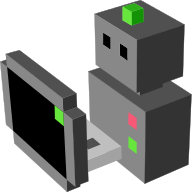Source code for morse.sensors.stereo_unit
import logging; logger = logging.getLogger("morse." + __name__)
from morse.core.services import async_service
import morse.core.sensor
from morse.core import blenderapi
from functools import partial
[docs]class StereoUnit(morse.core.sensor.Sensor):
"""
The purpose of this component is to link together one or more
cameras, and provide them with the possibility to move together as a
single unit. It will also provide the connection interface to use
the information of the cameras attached to it. In the case of two
cameras, it will provide the stereo information generated from the
two camera images.
Related components
------------------
A stereo unit needs to be the parent of one or more :doc:`cameras
<../sensors/video_camera>`. Otherwise, it does no useful function.
The movement of the stereo unit is implemented by making it the child of a
:doc:`Pan-Tilt unit <../actuators/ptu>` actuator.
Here is an example of how to construct the whole stereo system to mount on top
of a robot, using the Builder API. Note the order in which components are
appended to each other, as this is important to get the desired functionality:
.. code-block:: python
from morse.builder import *
# Add a robot
atrv = ATRV()
atrv.translate(z=0.1000)
# A pan-tilt unit to be able to orient the cameras
Platine = PTU()
Platine.translate(x=0.2000, z=0.9000)
atrv.append(Platine)
# The STEREO UNIT, where the two cameras will be fixed
Stereo = StereoUnit()
Stereo.translate(z=0.0400)
Platine.append(Stereo)
# Left camera
CameraL = VideoCamera()
CameraL.translate(x=0.1000, y=0.2000, z=0.0700)
Stereo.append(CameraL)
CameraL.properties(capturing = True)
CameraL.properties(cam_width = 320)
CameraL.properties(cam_height = 240)
CameraL.properties(cam_focal = 25.0000)
# Right camera
CameraR = VideoCamera()
CameraR.translate(x=0.1000, y=-0.2000, z=0.0700)
Stereo.append(CameraR)
CameraR.properties(capturing = True)
CameraR.properties(cam_width = 320)
CameraR.properties(cam_height = 240)
CameraR.properties(cam_focal = 25.0000)
"""
_name = "Stereo Camera Unit"
def __init__(self, obj, parent=None):
""" Constructor method.
Receives the reference to the Blender object.
The second parameter should be the name of the object's parent.
"""
logger.info('%s initialization' % obj.name)
# Call the constructor of the parent class
morse.core.sensor.Sensor.__init__(self, obj, parent)
self.num_cameras = 0
self.camera_list = []
# Create a list of the cameras attached to this component
for child in obj.children:
# Skip this object if it is not a component
# It is most likely just a geometric shape object
try:
child['Component_Tag']
except KeyError:
continue
camera_name = child.name
# Store only the name of the camera All data from the camera
# can be accessed later by using
# blenderapi.persistantstorage().componentDict[camera_name],
# which will return the instance of the camera object
self.camera_list.append(camera_name)
self.num_cameras += 1
logger.info("Stereo Unit has %d cameras" % self.num_cameras)
logger.info('Component initialized')
[docs] def capture_completion(self, answer):
self._expected_answer-= 1
if self._expected_answer == 0:
status, res = answer
self.completed(status, res)
[docs] def interrupt(self):
for camera in self.camera_list:
camera_instance = blenderapi.persistantstorage().componentDict[camera]
camera_instance.interrupt()
@async_service
def capture(self, n):
"""
The service takes an integer an argument and dispatch the call
to all its individual cameras. The service ends when each camera
has terminated its work.
:param n: the number of call to each individual camera
"""
self._expected_answer = self.num_cameras
for camera in self.camera_list:
camera_instance = blenderapi.persistantstorage().componentDict[camera]
camera_instance.capture(partial(self.capture_completion), n)
[docs] def default_action(self):
""" Main function of this component. """
pass
